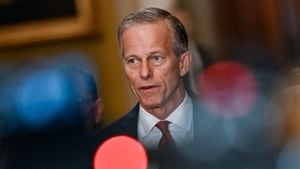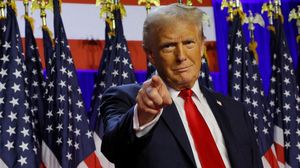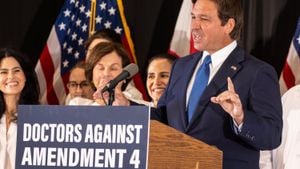Americans woke up to the reality of a new political era on November 6, 2024, following Donald Trump’s victorious return to the White House. The day opened with the bubbling anticipation of the end of one of the most bizarre and fiercely contested electoral campaigns, but as the dust settled, many were left grappling with the consequences of this seismic shift.
The sentiment was embodied by Frida Berrigan, who reflected on the state of America since Trump’s last presidency from January 20, 2017, to January 6, 2021, when the country nearly dissolved under the weight of chaos. “Count on one thing: On January 20, 2025, we will find ourselves in a new world,” she wrote, emphasizing how the electoral choices emerged from more than mere political strategy, digging deep instead, with roots entwined within the cultural fabric of the nation.
Berrigan’s reflections echoed the widespread feelings of confusion and trepidation as many Americans surveyed the aftermath of the election. She articulated the dissonance felt by numerous citizens who found themselves wrestling to comprehend the intentions and motivations behind Trump’s resurgence.
Statistics painted the election outcome with uncomfortable clarity. Trump garnered around 75 million votes, supported by various demographics, yet Berrigan posed pointed questions about the moral and social ramifications his presidency would bring. Her internal lament was shared by many who questioned how the American populace could overlook stark societal issues of racism and misogyny reflected within Trump’s political narrative.
But heads didn’t just shake at the results. The focus shifted toward the nuts and bolts of the electoral process, especially concerning Wisconsin, noted as the most competitive state during the campaign. The Marquette Law poll surveyed voters multiple times leading up to election day, offering insights on their preferences between Trump and Vice President Kamala Harris.
Polling results suggested stark demographic divides; 57% of men leaned toward Trump contrasted with 41% of women supporting the Vice President. Age and education leveled additional insights, with young voters favoring Democratic candidates and college-educated individuals rallying behind Harris.
Key issues drove voter preferences: 39% of respondents rated the economy as the foremost concern, with abortion and immigration rights following—reporting 15% and 13% respectively. Notably, economic dissatisfaction persisted, even with evidence of strong job growth and low unemployment before the election, possibly fueled by rising inflation rates affecting everyday pricing.
Post-election analysis by political commentators honed in on Harris's abbreviated campaign, lasting just 107 days, attributing her loss to insufficient time for voters to embrace her brand and background. Many pointed fingers at the Democratic Party’s failure to rally its base effectively. Reformist narratives highlighted the missed opportunities to amplify issues such as abortion rights—especially during public unrest stemming from judicial rulings surrounding reproductive health.
Meanwhile, commentators like David French unfolded another layer of analysis, dissecting the impact of cancel culture and identity politics. He explained how Trump’s campaign thrived among groups feeling marginalized by leftist ideology. According to French, his campaign’s incendiary rhetoric truly struck chords with voters who responded to perceptions of progressive overreach. He underscored political polarization, surmising Harris stepped away from her roots, intending to appeal to broader electorate segments, but this instinct failed to electrify her base.
On the flip side, Trump's narrative thrived on exacerbated emotions, tapping deeply passionate grievances. His rhetoric attracted diverse groups, bolstered by voter dissatisfaction with Democratic handling of social issues, creating fertile ground for exaggerated promises of patriotism and national strength. French’s reflections underscored lines drawn within societal factions between traditional, left-leaning ideologies and populist, right-wing sentiments, marking stark contrasts underscored throughout national discussions.
By calling out Republican choices and exposing cultural missteps, left-leaning commentators delved deeply, identifying patterns woven by decades of political disillusionment within American voters. They posited how changing attitudes among younger voters could be undermined by prevailing societal divisions perpetuated through rhetoric and media portrayals.
Among the most compelling discussions circled the persistent shadow cast by Russia's perceived connection to Trump. Following the election, several publications brought forward narratives concerning the influence of Vladimir Putin’s government over Trump’s political maneuverings, emphasizing fresh revelations drawn from two recent books by former investigators closely observing those ties. While well-documented by Washington Spectator, the inquiries pointed to the growing evidence of Russia’s efforts to destabilize American politics for its own advantage.
Coverage put forth by The Washington Spectator underscored how evidence compiled from infiltrations by Moscow cultivated networks aimed at sowing discord among U.S. citizenry. Notably, the U.S. director of national intelligence provided alarming confirmation of manipulative tactics, encapsulating attempts to undermine trust within democratic institutions. Commentators emphasized how foreign interference could leave unsettling legacies within U.S. politics.
The fallout from this complex, multifaceted narrative continued to provoke intense debates surrounding American identity and future political landscapes. Contributing factors such as economic disparity, demographic divisions, and geopolitical influences will undoubtedly spark conversations as citizens engage with the new national paradigm.
Berrigan’s prophetic depiction of societal left and right coalescing under the storm clouds of the Trump presidency reveals the depth of complexity entwined within the American electoral process. She shared visions, pausing to reflect on the power of imagination as sustenance during turbulent times—a reminder to maneuver through the noise and aspirations for generational change.
With the extensive polarization evident within the discussions spanning the political spectrum, it remains clear: the American people are confronted with the arduous task of approaching civic life amid looming uncertainties. Understanding the nuances behind Trump’s return to power requires more than mere surface-level analysis. A thorough examination led by the nuances of American life will chart the paths for future action.
What’s next for the political arena? With the dust settling post-election, there are booming rallies on the ground, manifested as grassroots movements begin coalescing around social justice issues, economic concerns, and entrenched responses to the governmental organization. Citizens unite markedly, poised to vocalize how they envision their world, taking steps to unite indigenous voices to articulate rights and struggles amid tumultuous political battles.



